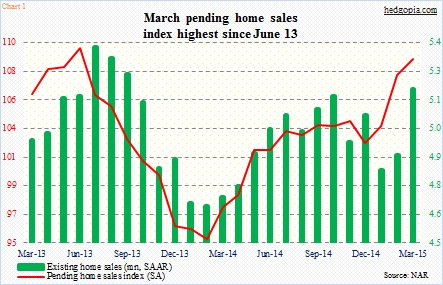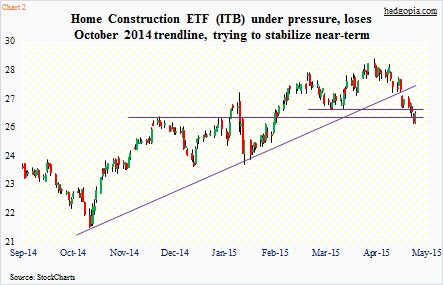Back on April 23rd, I wrote a piece on U.S. housing, arguing the importance of $26, and then $24, on the iShares Dow Jones US Home Construction ETF (ITB).
The ETF ($26.32) closed at $27.45 on April 22nd, having lost its 50-day moving average. It continued to remain under pressure for the next several sessions.
Last week, some signs emerged that it was trying to stabilize. Thursday’s selling stopped near the 150-day moving average (at $25.73). And Friday it rallied some. The daily indicators are now grossly oversold, so a trade could be developing here in the short-term.
Fundamentally, March sales were mixed – existing homes were strong but new homes weak. The pending home sales index has had a nice uptick since December (Chart 1). This week, the only housing-related data on schedule is mortgage applications (Wednesday); it comes out every week. No major homebuilder will be announcing earnings. From the perspective of news, it potentially is a safe week.
Having said that, in the intermediate-term, it is probably premature to bet that the Home Construction ETF (ITB) selling is over. It has lost the October 2014 trendline (Chart 2). Moving averages – from 10- to 20- to 50-day – have also turned lower. And weekly momentum indicators are under pressure, with some of them approaching the middle of the range; at times, selling can stop right here, other times, downward momentum can continue.
iShares Dow Jones US Home Construction ETF (ITB) Chart
Not knowing which way it is going to go and given the oversold conditions near-term, short puts can be used to generate some income.
Weekly (May 8th) 26.50 ITB puts are selling for $0.45. If the Home Construction ETF cannot rally, then it turns into an effective long at $26.05. If by Friday it rallies 0.7 percent, premium is kept.
Note that the options prices mentioned above are constantly changing and may not be available. Thanks for taking the time to read this post.
Follow Paban On Twitter: @Hedgopia
Read more from Paban on his blog.
No position in any of the mentioned securities at the time of publication. Any opinions expressed herein are solely those of the author, and do not in any way represent the views or opinions of any other person or entity.










